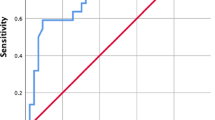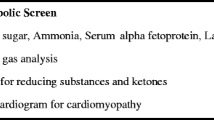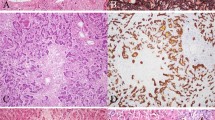Abstract
Background
Acute liver failure (ALF) caused by Wilson disease (WD) is always fatal. Therefore, a quick diagnosis of WD is needed to start immediate management. This study aims to determine the ratio of aspartate aminotransferase to alanine aminotransferase (AST/ALT) and the ratio of alkaline phosphatase to total bilirubin (ALP/TB) in diagnosing Wilsonian acute liver failure (WALF) in children.
Methods
Sixty children with acute liver failure were included in this study, of whom 40 had WALF and 20 had a non-Wilsonian acute liver failure (non-WALF). The serum ALT, AST, alkaline phosphatase, and total bilirubin of each blood sample were measured. We evaluated the sensitivity and specificity of AST/ALT ratio and ALP/TB ratio in WALF diagnosis.
Results
Consanguinity and Kayser-Fleischer (K-F) rings were found in 32.5% and 72.5% of WALF cases, respectively. The mean hemoglobin, median ALT, median alkaline phosphatase, and mean ceruloplasmin of children with WALF were lower than those in the non-WALF group. In WALF cases, the median AST/ALT ratio was higher than in non-WALF cases. The sensitivity, specificity, positive predictive value (PPV), negative predictive value (NPV), and diagnostic accuracy of the ratio of AST to ALT were 70%, 95%, 96.5%, 61.3% and 78.3%, respectively. However, when the cutoff value is ≥ 1.85, the maximum sensitivity produced by the AST/ALT ratio is 77.5% and the specificity is 95%. The sensitivity, specificity, PPV, NPV, and diagnostic accuracy of the ratio of ALP/TB < 4 were 32.5%, 100%, 100%, 42.5%, and 55%, respectively. The overall mortality rate was 50%, while the WALF mortality was 60%.
Conclusion
A positive AST/ALT and ALP/TB ratio strongly suggest WALF, but a negative result does not exclude WALF. We cannot use these ratios as a diagnostic tool for children with WALF. In WALF cases, the mortality rate is remarkably high, and the high score of the new Wilson index predicts the mortality rate without liver transplantation.

Similar content being viewed by others
References
Wang JS, Lu Y, Wang XH, Zhu QR. Urinary copper/zinc ratio: a promising parameter for replacement of 24-hour urinary copper excretion for diagnosis of Wilson’s disease in children. World J Pediatr. 2010;6:148–53.
Ala A, Schilsky ML. Wilson disease: pathophysiology, diagnosis, treatment, and screening. Clin Liver Dis. 2004;8:787–805.
Ostapowicz G, Fontana RJ, Schiodt FV, et al. Acute Liver Failure Study Group. Results of a prospective study of acute liver failure at 17 tertiary care centers in the United States. Ann Intern Med. 2002;137:947–54.
Roberts E, Schilsky ML. A practice guideline on Wilson disease. Hepatology. 2003;37:1475–92.
Gitlin JD. Wilson disease. Gastroenterology. 2003;125:1868–77.
Berman DH, Leventhal RI, Gavaler JS, Cadoff EM, Van Thiel DH. Clinical differentiation of fulminant Wilsonian hepatitis from other causes of hepatic failure. Gastroenterology. 1991;100:1129–34.
Walshe JM, Dixon AK. Dangers of non-compliance in Wilson’s disease. Lancet. 1986;12:845–7.
Eisenbach C, Sieg O, Stremmel W, Encke J, Merle U. Diagnostic criteria for acute liver failure due to Wilson disease. World J Gastroenterol. 2007;13:1711-4.
Devarbhavi H, Singh R, Adarsh CK, Sheth K, Kiran R, Patil M. Factors that predict mortality in children with Wilson disease associated acute liver failure and comparison of Wilson disease specific prognostic indices. J Gastroenterol Hepatol. 2014;29:380-6.
McCullough AJ, Fleming CR, Thistle JL, et al. Diagnosis of Wilson’s disease presenting as a fulminant hepatic failure. Gastroenterology. 1983;84:161–7.
Korman JD, Volenberg I, Balko J, et al. Screening for Wilson disease in acute liver failure: a comparison of currently available diagnostic test. Hepatology. 2008;48:1167-74.
Taly AB, Meenakshi-Sundaram S, Sinha S, Swamy HS, Arunodaya GR. Wilson disease: description of 282 patients evaluated over 3 decades. Medicine (Baltimore). 2007;86:112–21.
Sallie R, Katsiyiannakis L, Baldwin D, et al. Failure of simple biochemical indexes to reliably differentiate fulminant Wilson’s disease from other causes of fulminant liver failure. Hepatology. 1992;16:1206–11.
Moores A, Fox SH, Lang AE, Hirschfield GM. Wilson disease: Canadian perspectives on presentation and outcomes from an adult ambulatory setting. Can J Gastroenterol. 2012;26:333–9.
Shaver WA, Bhatt H, Combes B. Low serum alkaline phosphatase activity in Wilson’s disease. Hepatology. 1986;6:859–63.
Devarbhavi H, Singh R, Adarsh CK. A simple prognostic model predicting outcome in children and adolescents with Wilson disease and acute liver failure and comparison with Wilson disease specific models. Hepatology. 2012;56 Suppl S1:962A [Abstract] [Google Scholar].
Tian Y, Gong GZ, Yang x, Peng F. Diagnosis and management of fulminant Wilson’s disease: a single center’s experience. World J Pediatr. 2016;12:209–14.
Socha P, Janczyk W, Dhawan A, et al. Wilson’s disease in children: a position paper by the Hepatology Committee of the European Society for Paediatric Gastroenterology, Hepatology and Nutrition. J Pediatr Gastroenterol Nutr. 2018;66:334–44.
Dhawan A, Taylor RM, Cheeseman P, De Silva P, Katsiyiannakis L, Mieli-Vergani G. Wilson’s disease in children: 37-year experience and revised King’s score for liver transplantation. Liver Transpl. 2005;11:441–8.
Author information
Authors and Affiliations
Contributions
Afsana Yasmin and Md. Rukunuzzaman designed the research. Afsana Yasmin and Zannatul Ferdous Sonia collected the data. Afsana Yasmin, Rubaiyat Alam, and Kamal Hossen analyzed the data. Afsana Yasmin and Md. Rukunuzzaman wrote the manuscript. A S M Bazlul Karim closely supervised the whole study from the period of protocol establishment to end of study by repeated correction and gave final approval.
Corresponding author
Ethics declarations
Conflict of Interest
AY, MR, ASMBK, RA, KH, and ZFS declare that they have no conflict of interest.
Ethics statement
The study was performed conforming to the Helsinki declaration of 1975, as revised in 2000 and 2008 concerning human and animal rights, and the authors followed the policy concerning informed consent as shown on Springer.com
Disclaimer
The authors are solely responsible for the data and the contents of the paper. In no way are the honorary editor in chief, editorial board members, the Indian Society of Gastroenterology or the printer/publishers responsible for the results/findings and content of this article.
Additional information
Publisher’s note
Springer Nature remains neutral with regard to jurisdictional claims in published maps and institutional affiliations.
Rights and permissions
About this article
Cite this article
Yasmin, A., Rukunuzzaman, M., Karim, A. et al. Ratio of aspartate aminotransferase to alanine aminotransferase and alkaline phosphatase to total bilirubin in Wilsonian acute liver failure in children. Indian J Gastroenterol 41, 224–230 (2022). https://doi.org/10.1007/s12664-022-01244-5
Received:
Accepted:
Published:
Issue Date:
DOI: https://doi.org/10.1007/s12664-022-01244-5




